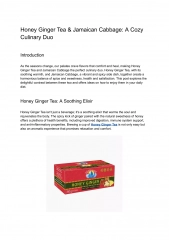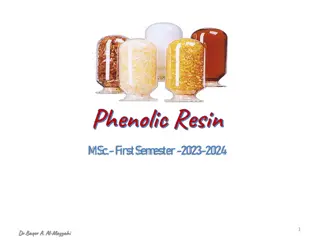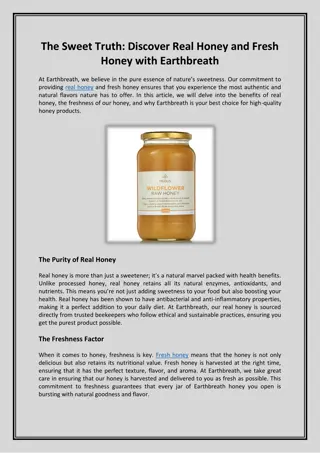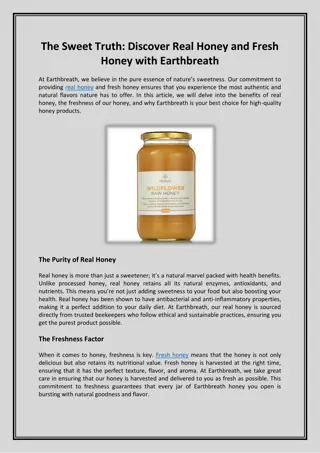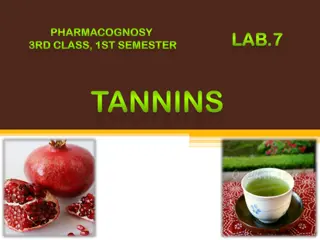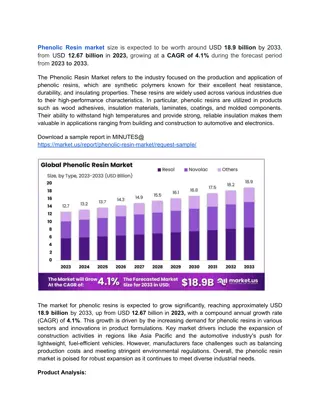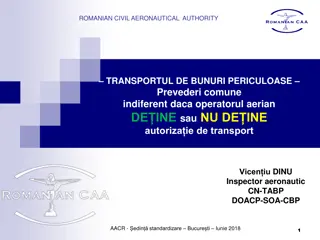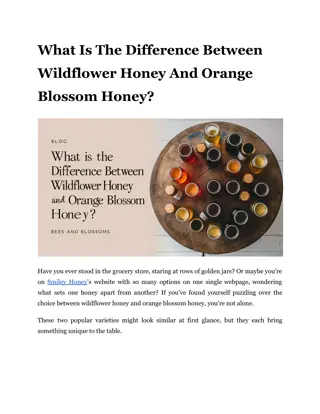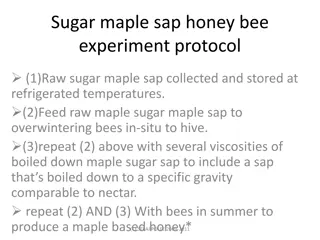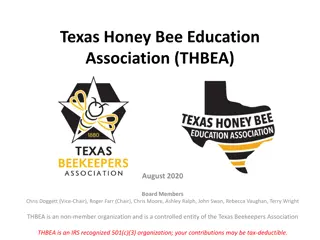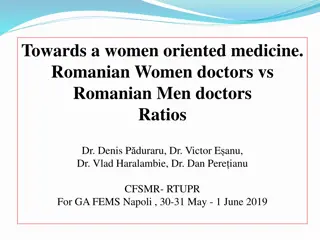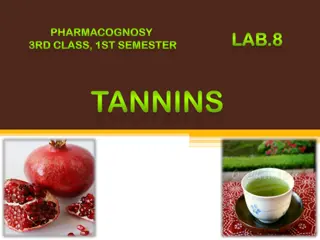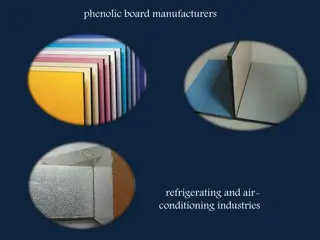Assessment of Total Phenolic and Total Flavonoid Contents in Romanian Monofloral Honey
Honey has been revered for its medicinal properties since ancient times, attributed to its antioxidant qualities. This study examined the total phenolic and flavonoid contents in various mono-floral honey samples from Romania and their correlations with different physicochemical parameters. The findings revealed significant levels of polyphenols and flavonoids, showcasing the honey's antioxidant potential and its importance in human nutrition.
Download Presentation

Please find below an Image/Link to download the presentation.
The content on the website is provided AS IS for your information and personal use only. It may not be sold, licensed, or shared on other websites without obtaining consent from the author.If you encounter any issues during the download, it is possible that the publisher has removed the file from their server.
You are allowed to download the files provided on this website for personal or commercial use, subject to the condition that they are used lawfully. All files are the property of their respective owners.
The content on the website is provided AS IS for your information and personal use only. It may not be sold, licensed, or shared on other websites without obtaining consent from the author.
E N D
Presentation Transcript
ASSESSMENT OF TOTAL PHENOLIC AND TOTAL FLAVONOID CONTENTS AND THEIR CORRELATION WITH SOME PHYSICOCHEMICAL PARAMETERS OF MONOFLORAL ROMANIAN HONEY Aida Albu, Razvan-Mihail Radu-Rusu*, Daniel Simeanu*, Cristina-Gabriela Radu-Rusu and Ioan Mircea Pop Ion Ionescu de la Brad Iasi University of Life Sciences, 700489, 8 Mihail Sadoveanu Alley, Iasi, Romania Email : albu.aida@uaiasi.ro
ABSTRACT Since ancient times, honey has been considered not only a sweet food but also known as a remedy against diseases, due to its antioxidant properties. The purpose of this study was to assess the total phenolic and flavonoid contents from Romanian raw monofloral honey and to establish their correlations with several qualitative parameters. In 2019, 28 samples were harvested: 8 acacia; 7 linden; 5 rapeseed, 5 sunflower and 3 mint, then analyzed in accordance with standardized methods, to measure: color intensity, water insoluble solids content, refractive index, moisture content, solid substances content, total soluble substances content, specific gravity, pH, free acidity, ash content, electrical conductivity, total phenols content and total flavonoids content. Pearson test shown several correlation levels of total phenols content with other compounds: strong positive with total flavonoids (r=0.76) and color intensity (r=0.72); moderate positive with free acidity (r=0.57), ash content (r=0.51) and electrical conductivity (r=0.53); weak negative with pH (r=-0.23). For total flavonoids content, correlations were: strong positive with color intensity (r=0.81), ash content (r=0.76) and electrical conductivity (r=0.73); fairly strong positive with free acidity (r=0.65); low positive between total flavonoids content and moisture (r= 0.35). The relevant levels of polyphenols and flavonoids identified in the analyzed honey demonstrate its antioxidant potential, as essential nutritional and sanogenic features in human nutrition. Keywords: honey, quality, phenolic content, flavonoid content, Pearson s correlation
Introduction Honey bee has been used as food and also as medicine since ancient times. Properties of this beehive product like antimicrobial, anti-inflamatory, antioxidative activities have been recognized as having beneficial effects on the human body. Many studies have shown that the composition and antioxidant activity of honey depends on several factors that can directly or indirectly affect its quality such as: bee species, geographic area, plants, weather, harvesting technique and storage condition. Antioxidant capacity of this complete food has been correlated with the amount of some substances that are present in honey composition: enzymes, polyphenolic compounds (phenolic acids, phenolic acid derivates, flavonoids), proteins, amino acids and other compounds. Aim The aim of this research was to assesed total phenolic and total flavonoids contents from monofloral raw honey and to establish their correlations with several qualitative parameters.
ACACIA 8 SAMPLES (A) LINDEN 7 SAMPLES (L) RAPESEED 5 SAMPLES (R) ROMANIA SUNFLOWER 5 SAMPLES (SF) MINT 3 SAMPLES (M) 28 raw honey samples 4 counties: Botosani: A7, A8, L6, L7, R5, SF4, SF5 Iasi: A1, A2, A3, A4, L1, L2, R1, R2, SF1, SF2 Vaslui: A5, A6, L3, L4, L5, R3, R4, SF3 Tulcea: M1, M2, M3
Method 50% honey aqueous solutions were spectrophotometrically analyzed at 635 nm (Shimadzu UV-1700 Pharma Spec); the absorbance units were converted in mm Pfund determined by the gravimetric method; the results were expressed in g/100 g honey read on the ABB Kruss AR 2008 refractometer refractometric method (ABB Kruss AR 2008 refractometer, with temperature correction); the results were expressed in g/100 g honey 100- M (moisture); the results were expressed in g/100 g honey Parameter Reference Ratiu I.A. et al., 2020 Color Water insoluble solids (WIS) Refractive index (RI) SR(Romanian Standard) 784-3:2009: Honey bee. Part 3: Analytical methods Moisture (M) Solid substances (SS) USDA, Extracted honey grading manual, United States Department of Agriculture. Standards for Honey Grading. USDA, Washington DC, 1985 Total soluble substances (TSS) refractometric method with ABB Kruss AR 2008 refractometer; the results were expressed in Brix determined by the gravimetric method with pycnometer; the results were expressed in g/cm3 Popescu N. and Meica S.,1997 Specific gravity (SG)
Method 10% (w/v) honey solution measured at WTW MULTI 3320 multiparameter titration method (10% (w/v) honey solution with 0.1 N NaOH), expressed in meq kg-1 Parameter Reference Bogdanov S., 2009; Sereia M.J. et al., 2017; SR(Romanian Standard) 784-3:2009: Honey bee. Part 3: Analytical methods pH Free acidity (FA) calcination method (550 C); the results were expressed in g/100 g 20% (w/w) honey solution (dry matter basis) in mili-Q water, measured at WTW MULTI 3320 multiparameter; the results were expressed in mS cm-1 Folin-Ciocalteu method modified from Bobi et al. (2008) and Sereia et al. (2017). The absorbance was measured at 742 nm against a blank (UV-1400 Shimadzu spectrophotometer). Standard calibration (gallic acid; 5 calibration points and 3 replicates; concentration ranging in 2-12 mg L-1 interval; y=0.089x+0.1147; R2=0.9972). The results were expressed in mg of quercetin equivalents (QE)/100g method with minor changes developed by Bobi et al. (2008) and Pontis et al. (2014). The absorbance was measured at 430 nm against a blank (UV-1400 Shimadzu spectrophotometer). Standard calibration (quercetin; 6 calibration points and 3 replicates; concentration ranging in 0.5-5 mg L-1 interval; y=0.1331x+0.0112; R2=0.9997). The results were expressed in mg of quercetin equivalents (QE)/100g Ash Bogdanov S., 2009; Sereia M.J. et al., 2017; SR(Romanian Standard) 784-3:2009: Honey bee. Part 3: Analytical methods Electrical conductivity (EC) Total phenols content (TPC) Bobi et al. (2008) and Sereia et al. (2017) Total phenols content (TPC) Bobi et al. (2008) and Pontis et al. (2014)
(Council Directive 2001/110/CE concerning honey) In present research Samples: 2 samples acacia, 2 samples linden, 2 samples rapeseed, 1 sample sunflower WIS 0.1% Sample: 1 sample rapeseed M 20% WIS Impurity content for commercial honeys: 0.1% for filtered honey 0.5% for pressed honey Moisture Limit: 20% moisture
(Council Directive 2001/110/CE concerning honey) Free acidity Limit: 50 meq kg-1 Electrical conductivity Limit: 0.8 mS cm-1
Correlations between some honey parameters Figure 2. Correlation between ash and electrical conductivity (r=0.95) Figure 1. Correlation between color and total flavonoids content fi honey samples (r=0.81)
Pearson's correlation Correlations of honey parameters Strong positive linear correlation between: - RI and : SS (r=+1); TSS (r=+1); SG (r=+0.99); - Color and: TPC (r=+0.72); TFC (r=+0.81); - TFC and: Ash (r=+0.76); EC (r=+0.73); TPC (r=+0.76); - Ash and EC (r=+0.81); - SS and: TSS (r=+1); SG (r=+0.99); Moderate positive linear correlation between: - Color and : FA (r=0.68); Ash (r=0.49); - FA and: Ash (r=0.58); EC (r=0.55); TPC (r=0.57); TFC (r=0.65); - TPC and: Ash (r=0.51); EC (r=0.53); Figure 3. Head map of Pearson's correlation between honey parameters
Conclusions Romanian honey is appreciated for its quality, this fact is proved by the large amount of honey exported. The relevant levels of polyphenols and flavonoids identified in the analyzed honey demonstrate its antioxidant potential, as essential nutritional and sanogenic features in human nutrition.
Selective References 1.Geana, E.I.; Ciucure, C.T. Establishing authenticity of honey via comprehensive Romanian honey. Food Chemistry2020, 306. doi.org/10.1016/j.foodchem.2019.125595. 2.Ciulu M., Spano N., Pilo M.I., Sanna G. Recent Advances in the Analysis of Phenolic Compounds in Unifloral Honeys. Molecules2016, 21, 451. doi: 10.3390/molecules21040451. 3.da Silva, P.M.; Gauche, C.; Gonzaga, L.V.; Costa, A.C.O.; Fett, R. Honey: Chemical composition, stability and authenticity. Food Chem. 2016, 196, 309 323. 4.de-Melo, A.A.M.; de Almeida-Muradian, L.B.; Sancho, M.T.; Pascual-Mat , A. Composition and properties of Apis mellifera honey: A review.A. J. Apic. Res. 2017, 57, 5 37. dx.doi.org/10.1080/00218839.2017.1338444. 5.Pontis, J.A.; Costa, L.A.M.A.D.; Silva, S.J.R.D.; Flach, A. Color, phenolic and flavonoid content, and antioxidant activity of honey from Roraima, Brazil. Food Sci. Technol. 2014, 34, 69 73. 6.Al-Farsi, Mohamed; Al Amri, Abeer; Al-Hadhrami, Ahlam; Al-Belushi, Sharifa. Color, flavonoids, phenolics and antioxidants of Omani honey. Heliyon 2018, 4. 10.1016/j.heliyon.2018.e00874. doi.org/10.1016/j.heliyon.2018.e00874. 7.Ahmida, N.H.; Elagori, M.; Agha, A.; Elwerfali, S.; Ahmida, M.H. Physicochemical, heavy metals and phenolic compounds analysis of Libyan honey samples collected from Benghazi during 2009 2010. Food Nutr. Sci. 2013, 4, 33 40. 8.Cimpoiu, C.; Hosu, A.; Miclaus, V.; Puscas, A. Determination of the floral origin of some Romanian honeys on the basis of physical and biochemical properties. Spectrochim. Acta Part A2013, 100, 149 154. 9.Ratiu, I.A.; Al-Suod, H.; Bukowska, M.; Ligor, M.; Buszewski, B. Correlation study of honey regarding their physicochemical properties and sugars and cyclitols content. Molecules 2020, 25(1), 34. doi.org/10.3390/molecules2501003. 10.Romanian Standards Association. SR(Romanian Standard) 784-3:2009: Honey bee. Part 3: Analytical methods. Available online: https://e- standard.eu/en/standard/174480 (accessed on 16 April 2018). 11.USDA. Extracted Honey Grading Manual, United States Department of Agriculture. Standards for Honey Grading; USDA:Washington DC, USA, 1985. Available online: https://www.ams.usda.gov/sites/default/files/media/Extracted_Honey_Inspection_ Instructions%5B1%5D.pdf (accessed on 10 December 2018). 12.Popescu, N.; Meica, S. Bee products and their chemical analysis. In Produsele Apicole si Analiza lor Chimica; Diacon Coresi: Bucuresti, RO, USA, 1997. 13.Bogdanov, S. 2009: Harmonized Methods of the International Honey Commission. Available online: https://www.ihc-platform. net/ihcmethods2009.pdf (accessed on 30 May 2018). 14.Sereia, M.J.; Mar o, P.H.; Perdoncini, M.R.G.; Parpinelli, R.S.; de Lima, E.G.; Anjo, F.A. Chapter 9: Techniques for the Evaluationof Physicochemical Quality and Bioactive Compounds in Honey. In Honey Analysis; INTECH: London, UK, 2017; pp. 194 214. 15.Bobis, O.; Marghitas, L.; Rindt, I. K.; Niculae, M. & Dezmirean, D. Honeydew honey: correlations between chemical composition, antioxidant capacity and antibacterial effect. Scientific Papers Animal Science and Biotechnologies, 2008, 41(2), 271-277. 16.European Commission. Council Directive 2001/110/CE concerning honey. Off. J. Eur.Comm. 2002, L10, 47 52.


